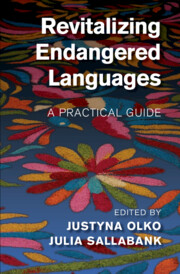Figures
1.1Traditional healing knowledge transmitted in Nahuatl. Engaged Humanities project field school, San Miguel Xaltipan, Mexico. Photo by Justyna Olko
1.2Indigenous communities that lose their languages often face a youth suicide problem. Suicide prevention program, Shoshone Reservation, Fort Hall, Idaho. Photo by Justyna Olko
1.2.1Revitalization workshop with young people. Photo by Sumittra Suraratdecha
1.2.2Linguistic and cultural revitalization program for all generations: Raising silkworm. Photo by Sumittra Suraratdecha
1.3.1Performance by the Wilamowianie Dance Group. Photo by Robert Jaworski, Polish Theatre in Warsaw
1.4.1Participatory workshop on reading Nahuatl historical texts in modern Nahuatl, Archivo General de la Nación, Mexico. Photo by Justyna Olko
1.4.2Participatory workshop in the community of San Miguel Xaltipan, Mexico. Reading a colonial document from the region. Photo by Justyna Olko
2.1.1Speaking Wymysiöeryś: Tymoteusz Król, the revitaliser of the language. Photo by Justyna Olko
8.1.1Performance in Wymysiöeryś, Der Hobbit, Polish Theatre in Warsaw. Photo by Robert Jaworski, Polish Theatre in Warsaw
9.1The performance and agency of Indigenous communities. The group of Zohuameh Citlalimeh, San Francisco Tetlanohcan, Mexico. Photo by Justyna Olko
9.2Local products sold during the Mother Tongue Day in Wilamowice. Photo by Piotr Strojnowski, © Engaged Humanities Project, University of Warsaw
9.3A local store with some names and announcements in Nahuatl, San Miguel Tenango, Mexico. Photo by Justyna Olko
12.2.1Mixtec, Ayuuk, and Nahua activists at the field school of the Engaged Humanities project, Mexico. © Engaged Humanities Project, University of Warsaw
12.2.2Justyna Majerska-Sznajder and Tymoteusz Król, revitalisers of Wymysiöeryś, greeted by a speaker of Nahuatl. San Miguel Tenango, Mexico. © Engaged Humanities Project, University of Warsaw
14.1A Nahua boy reading an ancient creation story written in his variant. Chicontepec, Mexico. Photo by Justyna Olko
14.2Katrina Esau and Sheena Shah introduce the newly developed Nǀuu alphabet charts. Photo by Matthias Brenzinger
14.3A postcard written by a young student of Manx. Photo by Justyna Olko
14.4An exercise book for (writing) the Lemko language (Робочий зошыт до лемківского языка), Barbara Duć/Варвара Дуць. © Engaged Humanities Project, University of Warsaw
15.2A Manx language class taught by Jonathan Ayres, Arbory School, Isle of Man. Photo by Justyna Olko
15.3Nahua children reading a pictorial dictionary. Chicontepec, Mexico. Photo by Justyna Olko
15.4.1A presentation of Lemko books by Olena Duć-Fajfer, the founder of the Lemko philology, and Petro Murianka, a Lemko poet, writer, and teacher. Photo by Jarosław Mazur
15.6.1A girl in a gákti (traditional Sámi dress). Photo by Ibbá Lauhamaa
15.6.2Reindeer meat will be smoked in a lávvu (lean-to-shelter). Photo by Pigga Keskitalo
16.1.1Performance in Wymysiöeryś, Uf jer wełt, Polish Theatre in Warsaw. ? Engaged Humanities Project, University of Warsaw
16.1.2Performance in Wymysiöeryś, Ymertihła, Polish Theatre in Warsaw. Photo by Krzysztof Kędracki, Polish Theatre in Warsaw
16.1.3Concert in Wymysiöeryś, the Majerski family. Photo by Marcin Musiał
16.6.2‘Carrusel’. Los sueños del tlacuache. © PRMDLC Project
17.1The Wide World of Apps. A possible sea of uncharted ‘Apps’ relevant to language revitalization workers. Developing expertise in all areas is daunting, perhaps even an impossible task
17.2Islands of Competence. Rather than feel overwhelmed by the vast number of areas that need to be learned, users can start small, building ‘islands of competence’ in a few specific skill sets
17.3Expanding Islands of Competence. Over time, a user can expand their islands of competence, forming larger islands, chains of islands or even turning islands into entire continents
17.1.1Ben Levine and Julia Schulz documenting Passamaquoddy-Maliseet natural conversation as developed with Margaret (Dolly) Apt. Photo by Ian Larson



